#Interactive LED Flat Panel
Explore tagged Tumblr posts
Text
The blog explores how Interactive Flat Panels (IFPs) enhance learning by boosting engagement, enabling interactive lessons, and integrating multimedia. It highlights their accessibility, adaptability, and role in modern teaching for better student outcomes.
#Interactive Flat Panel#Interactive Flat Panel Display#Interactive LED Flat Panel#Interactive Flat Panel Cost
1 note
·
View note
Text
Choose Gladwin Group's Interactive Flat Panel Displays
#flat interactive panel#interactive display panel#interactive flat panel display#led interactive panel#interactive flat panel displays#interactive panels#ifp panels#ops for interactive panel#ifp panel#smart panel board#interactive led flat panel#interactive panels for education
0 notes
Text
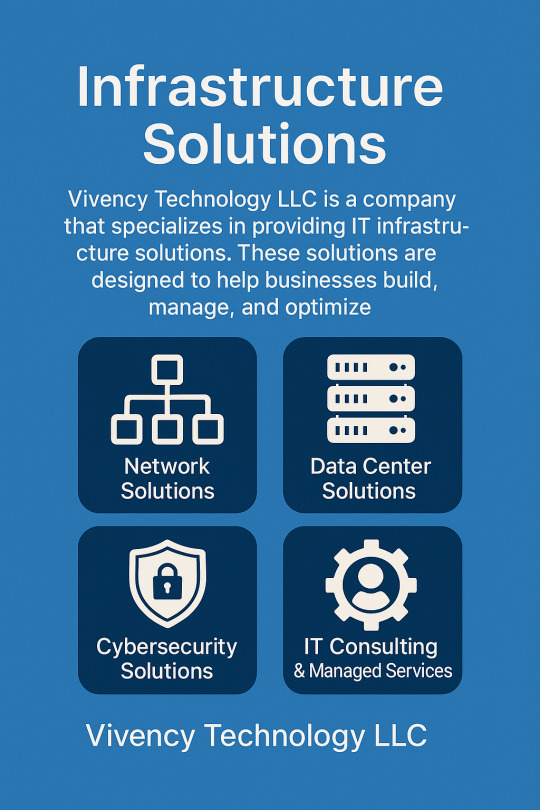
Vivency Technology LLC – IT Infrastructure Solutions at a Glance
A clean, professional infographic showcasing the core IT infrastructure services offered by Vivency Technology LLC. The design features a modern layout with icons representing key services such as Network Solutions, Data Center Solutions, Cybersecurity Solutions, and IT Consulting & Managed Services, all presented against a sleek blue background for a sharp, corporate look. Ideal for website banners, brochures, and social media promotions.
#Infrastructure Solutions#Networking Solutions#Security Solutions#AV Solutions#Smart Boards#Interactive Flat Panels#Projectors#School bell Solutions#Video Conference Solutions#Web Based School Bell Solutions#Indoor & Outdoor LED Screens#PA System Based School Bell Solutions
0 notes
Text
Is Your Interactive Flat Panel Secure? Tips for 2025
In today’s digital landscape, interactive flat panels (IFPs) have become an integral part of education, corporate meetings, and public displays. These smart displays offer seamless collaboration, but with increased connectivity comes the risk of cyber threats. As we step into 2025, securing your interactive flat panel is more crucial than ever. Here are some expert security tips from Infonicstech to safeguard your IFPs against potential threats.

1. Keep Software and Firmware Updated
One of the simplest yet most effective security measures is ensuring that your IFP’s software and firmware are regularly updated. Manufacturers release patches to fix vulnerabilities and enhance security. Check for updates frequently and apply them as soon as they become available.
2. Implement Strong Access Controls
Unauthorized access can lead to data breaches and misuse of your interactive flat panel. Use strong passwords and multi-factor authentication (MFA) to restrict access. Additionally, configure user roles and permissions to limit sensitive functionalities to authorized personnel only.
3. Secure Network Connections
Most IFPs operate on Wi-Fi or Ethernet networks, making them potential targets for cyberattacks. To enhance security:
Use encrypted connections (WPA3 for Wi-Fi, VPN for remote access).
Restrict guest access to a separate network.
Regularly monitor network activity for suspicious behavior.
4. Disable Unused Ports and Features
Many interactive flat panels come with multiple connectivity options, such as USB, HDMI, and Bluetooth. If not managed properly, these ports can become entry points for malware. Disable any ports or features that are not in use to minimize security risks.
5. Use Reliable Security Software
Install and maintain reliable antivirus and anti-malware solutions on devices connected to your IFP. Some advanced IFPs also support built-in security features—activate them for enhanced protection.
6. Encrypt and Back Up Important Data
Interactive flat panels often store and share sensitive data. Encrypt stored files and regularly back them up to a secure location. Cloud-based storage with encryption and access control mechanisms can also add an extra layer of security.
7. Conduct Regular Security Audits
Schedule routine security audits to identify vulnerabilities in your IFP setup. Regular assessments help stay ahead of potential risks and reinforce security measures.
8. Educate Users on Security Best Practices
Human error is a significant factor in security breaches. Train your team or students on best practices, such as:
Avoiding phishing scams.
Not downloading unauthorized applications.
Logging out after each session.
Secure Your Interactive Flat Panel with Infonicstech
At Infonicstech, we prioritize cybersecurity in all our interactive flat panel solutions. Our advanced security features and expert recommendations protect your devices from modern threats. Stay ahead of cyber risks in 2025 by implementing these security measures and investing in secure, high-quality IFPs.
0 notes
Text

Indoor and Outdoor LED Screen Displays in Dubai
The growing design culture in Dubai demands new ideas and creativity, and therefore LED screens in both indoor and outdoor atmosphere are very important. Shopping centers, banks, airports, and even the streets’ attractions are all giving rise to LED panels taking over the communication of institutions with their clients.
#av solutions in dubai#indoor led screen display#outdoor led screen display in dubai#interactive flat panel#av solutions
0 notes
Text
#Floor Standing Touch Screen Kiosk#Digital Signage Solutions#Digital Display Standee#Aluminum#Floor Standing Digital Signage#Digital Advertising Standee#OLED Led Display Standee#Double side#digital standee#Digital Signage Display#Digital Standee For Retail Stores android led standee#Interactive White Digital Board#Interactive Classroom Boards#PenTouch Interactive Flat Panel#Smart Board Interactive Flat Panel#Interactive Smart Board Finger Touch#Android Touch Screen Kiosk#Visitor Management Kiosk Systems#Touch Screen Information Kiosk#Smart Touch Screen Display Kiosk#Touch Panel Kiosk#Advertising Kiosk for Indoor
0 notes
Text

Alright. Let's break down this "oh" of an ending. NEGATIVE NANCY, COMING THROUGH
Spoilers, ho!
Ending a story is hard, if they're long or short. Whether you wrap up key threads or leave them open, you want some kind of takeaway that puts a period on things. Even in comics, where we know these characters will go on and on, ideally a story will end in a way that just... fits. Even amateur fic writers have loads of WIPs just sitting there because exactly how to end this damn thing eludes them.
I don't know if Rosenberg had an ending in mind when he started The Man Who Stopped Laughing. I don't know if he decided he'd figure it out by the end of it's year-long run. I don't know if DC Editorial lets people do that; it sounds insane, but if you've been paying attention to their current level of editorial "oversight," which I imagine is supposed to make concurrent titles mesh together reasonably well, I wouldn't be shocked if they let people wing it. Or, more likely, perhaps DC Editorial swooped in and made Rosenberg change the ending he had planned and that's why the result falls flat.
In any case, after 11 issues of enjoying myself, I'm left feeling deflated.
But let's start where #12 does, with the Joker who's been told he's John Keyser, a toxin'd henchmen that the real Joker made into a doppelganger for funsies. He approaches a hotdog vendor.

I'm stuck on "Hello. I've been looking for you"?? I didn't catch that on my first read. Joker has a favorite hotdog vendor? lol
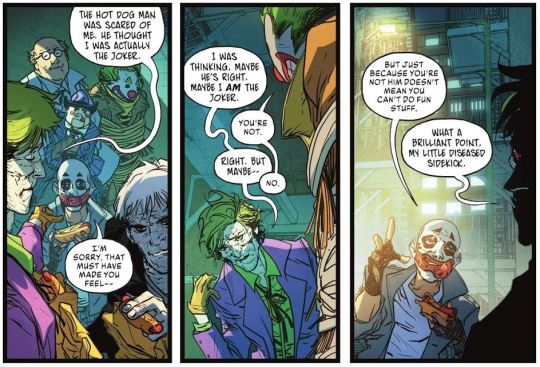
Shut up, Waffles!! All we have is your word for it!!
In any case, hey, Keyser Joker has already been Jokering this long, so yeah, why not keep going? And why not with help from poor woobie Jason, fresh from nearly getting himself killed in Gotham War?

Bruce did not fix Jason at the end of Gotham War, so his adrenaline is still triggering fear in his brain. But Keyser Joker has a solution for that!

It's a tiny dose of Joker toxin to take the edge off of Bruce's programming. Joker makes a point of saying that the effects are only temporary, though. (And like, I assume this is just the quick-fix solution Rosenberg came up with to pull off his own ending when told Bruce's plans for Jason over in the other titles.) Jason is skeptical of this "help," naturally, but Keyser Joker brings up their matching interest: getting rid of the other Joker.

Jason, why you gotta ruin Albert's good time? 🙄
Cut to Red Hood dragging a clown henchman through the streets of Gotham.
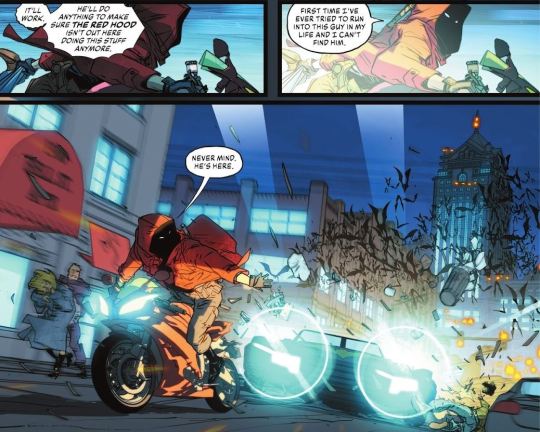
But "his" face being blacked out and some of the dialogue clue the reader in: things aren't what they seem.
DERAIL TIME: what is up with this batmobile?

Like from some other angles, it looks sportier, but in most of the panels it looks like an old Buick? lol ANYWAY.
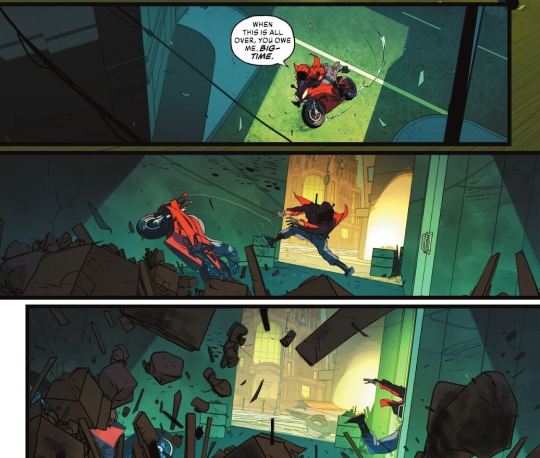
With the flaily way this person jumps off the bike and runs, I was sure that this was Keyser Joker and we might see Batman interact with him. Alas.

It's Ravager, who survived last issue's explosion. She's helping Jason 1) distract Batman and 2) get Albert out of harm's way, far from Keyser Joker's plan.

Naturally Keyser Joker is planning something more destructive than he's led Jason to believe. Also like…
The idea that Keyser Joker really is this John guy, not the real deal, is still not sitting fucking right with me. Seeing him here in another costume, with a goofy death train with mismatched eyes just like his, it feels like a signal that he actually is Joker and Waffles is either lying or mistaken somehow. Like compared to the other Joker, who we haven't seen in a costume? Who left Gotham for weird reasons? I really thought there was going to be a reverse reveal.
And since it doesn't come, I guess it's a good time to mention that! There is no reverse reveal of who the real Joker is. Things get a little muddy later, but…. hrm. HRM.
That said, the other Joker does something pretty dang Jokery: he shows up in a dirigible with his face on it.
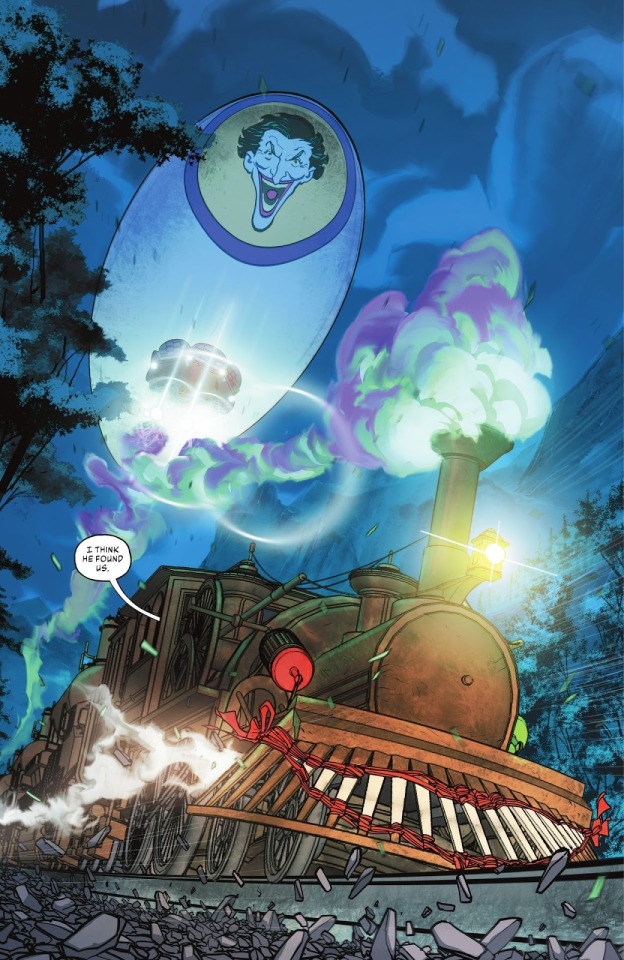
Killer Moth and a bunch of clown goons (that aren't supposed to be available because of Gotham War but WHATEVER) attach the dirigible to the train and it's pretty chaotic!

I love when villains are like, "Look I may kill people, but an endangered gorilla?! Get outta here!" 😂
Jason also arrives in style.

I guess he was observing Ravager's distraction?? Which feels like it defeats part of the purpose of having her do the distraction. But then he couldn't have this cool entrance in which he bludgeons people with a motorcycle. Trade offs!
Meanwhile, Real Joker makes it to the front of the train to confront Keyser Joker. One of Real's goons offers to shoot Keyser, but Real Joker wants to make this personal and kills the poor hench so he can do it himself.
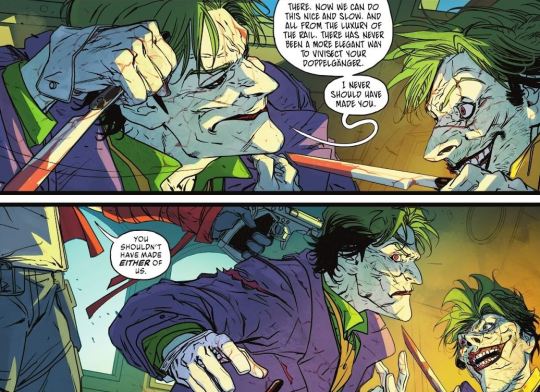
Jason coming in like YEEEEEAAAAHHHHH 😎
Then he gets the bad news.

Keyser is as casually suicidal as your average Joker! Also "Real" Joker never acknowledges Red Hood's identity, afaik. It's always Keyser Joker. Details like this got me thinking that reverse reveal was coming, AND YET.
That aside, next comes a fun comedy beat.

Real Joker going right for the hair!
Jason isn't going to let this be the end of it, of course, and once again Killer Moth must suffer at his hands.

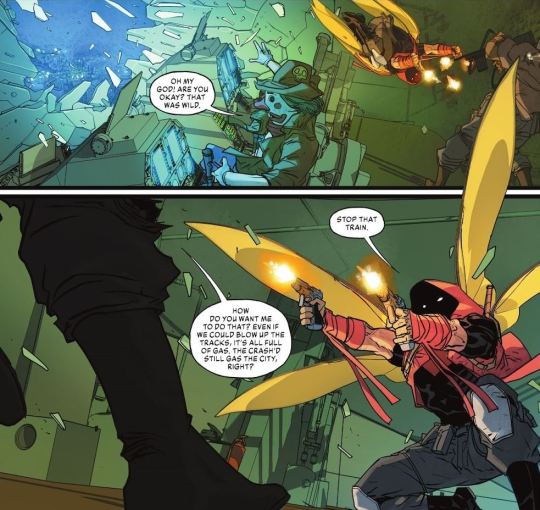

Jason shoots so many clowns. Just never the one he wants. 😞

Waaaaaaaaaaaaaait wait wait. You're telling me that Bruce knew about the imminent TWO JOKERS situation. But he decided to prioritize a report of Red Hood dragging a clown through the streets. When in the same breath he's saying there are other people coming to the scene with him, so he obviously could've sent someone else? On the same day Batman #139 is like "oooh Bruce is totally onto Joker now"? This is what you're telling me?? Augh.
Well, we can't rely on Batman right now, clearly, so it's up to Jason.

Meanwhile, Keyser Joker has told the other one that he actually does have a secret way off the runaway train safely. After they fight some more, the tune starts to change.

Alright so, this "deal," which would sort of start them back at square one, doesn't bother me because obviously it's on shaky-ass ground and one of them is definitely killing the other before this issue is over. What does bug me is the "franchising" line, for two reasons:
1) Is this supposed to imply that Real Joker is the one who was behind Joker Incorporated in the Batman Incorporated issues, not a third one?
2) I was just SO SURE it was another indication we were getting a reverse reveal. Joker absolutely does not love the franchising idea. That's kind of been the point of this whole series. The genuine Joker in Keyser Joker's hallucination/memory said that having two Jokers around is stupid. HRRRRMMM.
Anyhow, they leave the train together, though the escape plan is literally just jumping off, which has more issues than they bargained for.
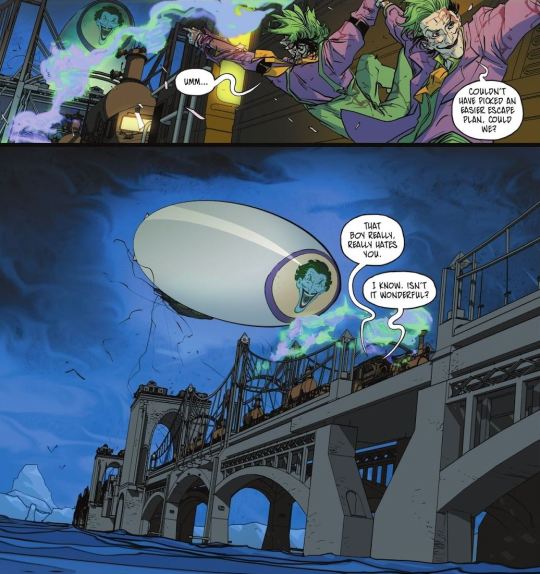
So do you think, assuming the Gotham War writers actually communicated at least a little, that Zdarsky asked Rosenberg what he needed Jason for at the end of TMWSL, and Rosenberg was like, "oh I need him to heroically crash a toxic blimp and almost die?" And then Zdarsky was like, "er, I need him to heroically fly a plane into a magic meteor and almost die?" And then they just shrugged and closed the Zoom?
But yeah, the blimp crashes, and I'm sort of confused because I thought that earlier Bruce was saying that even if the toxin gets into the water, it'll still make it's way to the city. So for one thing, it's still exploding in the air and it's still gonna drift. And the parts that dissolve in water are still gonna drift. There's a part to the equation missing here.
But these two are just thrilled at the excitement.

Until the sudden yet inevitable betrayal.
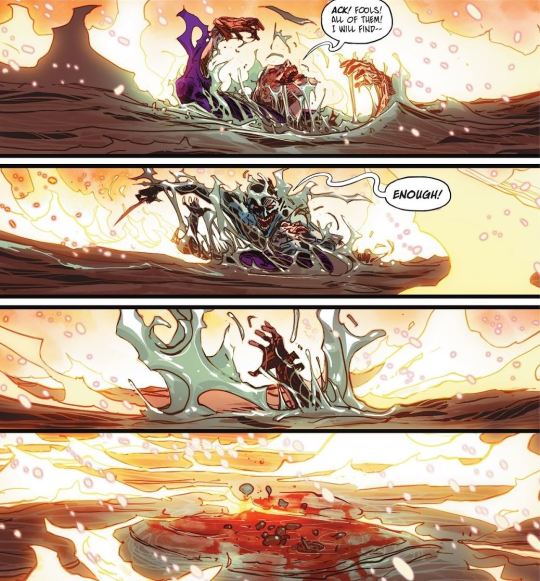
BUT WHO WAS JOKE
Shortly after this, Ravager shows up with Manhunter, who also survived last issue's explosion. (It just doesn't come up at all. Like it doesn't have to, I guess, but it's just weird that there's not a word or wound about it.) Ravager dives into the water looking for Jason, because she instinctually knows he did something grand and dumb. She finds him among the clown bodies and brings him to shore.

Nothing can kill this man! He came back from the dead with nine lives! And also maybe that Lazarus resin from TFZ is still helping, I dunno.
Elsewhere along the shore, what's left of both Jokers' crews find themselves waiting in the same spot for the Joker they expect to be triumphant.

You know what. I'm soured on Waffles now. Leave him.
And then, from the water…

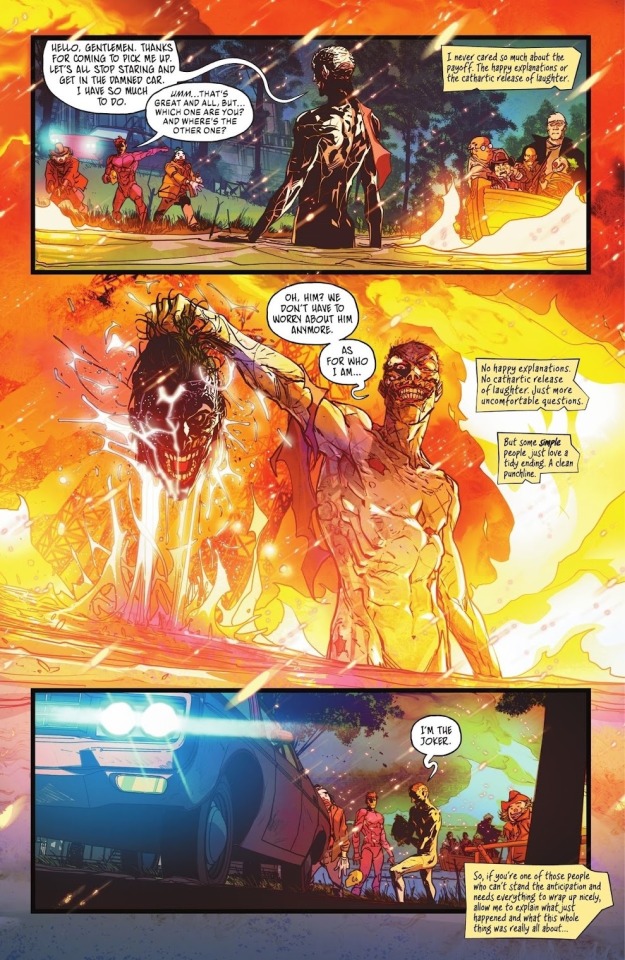
And that's it. That's how it ends. With a sort of snide cop-out?
Like, it's Joker's POV, so yeah, you could say the dickish tone is just him. But following this story for a year, and then seeing it end with simply the old "you'll never know which Joker prevailed," it doesn't feel clever or whatever this is going for. It just feels obnoxious.
Honestly, it feels like the same takeaway as freaking Three Jokers. 😐 That it doesn't matter who Joker is. All the lead-up to this, where maybe we get a tiny bit of depth and development, even if just in this story, eh. Doesn't matter! We're ending this with blah payoff.
On the other hand, the part of about about there being more questions, about this ending not being tidy, makes me think that this is leaving open the possibility that Keyser Joker actually was the real one. After all, we don't get a flashback to the actual events. The events we see are part of a hallucination, and Keyser never said he had clear memories of being the real or the fake one. He just went from assuming he was the real one to taking Waffles' word for it that he was the henchman.
Also, Keyser Joker was always the Joker giving narration. And the narration boxes for the Final Joker at the end remain in his style. So it seems like we actually have a huge indication of which Joker prevailed-- unless we're meant to assume that if the other Joker prevailed, he merely took over the narration.
I mean, this is what we have. So if I can just choose what I want to believe, I'm going to believe both that Keyser was actually the real guy and that he won. But it puts a real sour taste in my mouth to be super engaged with a story and wanting an ending that says something about Joker's character… and the ending is just that one murders the other and you don't know who, neener neener. It's anticlimactic. It's a predictable direction that I thought SURELY Rosenberg wouldn't go in. It feels like a dick move.
And... what else is there to say? So ends my year of consistently buying a comic, I guess. Nothing else has really grabbed me like TMWSL did, though City of Madness looks promising. After the multiverse and Gotham War stuff, I'm not about to start picking up Zdarsky's Batman. #139 had plenty I should enjoy, but it's soured by Zdarsky deciding to bring a canonical take to the three Jokers concept for some ungodly reason.
A new three Jokers take feels extra stupid after a year of a story about two Jokers. And the second Joker in TMWSL isn't even taken into account in Zdarsky's story. Based off that #135 scene, it really looks like he's going to say that Darwin Halliday accidentally copied TKJ Joker somehow. lmao Why. Why do we have to do this. Why can't this just be one of the things that gets retconned away. I just want my murderclown to be fun.
I need to get back to my list of unread older comics. Or read One Operation Joker! I didn't think I was interested, but I think a random goofy premise is actually just what I need.
167 notes
·
View notes
Text
How Custom Glass Manufacturing Is Revolutionizing Modern Architecture
Over the past century, architecture has undergone transformative shifts driven by technological advancements, societal needs, and aesthetic aspirations. Materials like steel, concrete, and wood have long dominated the architectural landscape. However, the 21st century has witnessed the emergence of glass not merely as a transparent façade but as a dynamic, structural, and multifunctional element. This transformation is fueled by the evolution of custom glass manufacturing, a field that enables architects to transcend previous limitations in design and functionality. With increasing demand for buildings that are sustainable, secure, and visually striking, custom glass has become an indispensable tool in the modern architect's toolkit. The trend reflects a broader cultural and technological movement toward materials that are both expressive and high-performing, aligning architectural design with contemporary values and user expectations.
Historical Context: From Glass Panes to Architectural Marvels
Glass has been used in architecture for centuries, dating back to ancient Roman glass windows. However, its use was largely ornamental or functional in limited capacities due to technological constraints. The industrial revolution enabled the mass production of flat glass, which led to its broader application in buildings. Yet it wasn't until the late 20th century that glass started to be considered a potential structural component. Advances in lamination, tempering, and coating technologies allowed architects to explore new possibilities, from transparent walls to load-bearing elements. These innovations marked the beginning of a new era in which glass was no longer just a cladding material but an integral part of structural and environmental design. As the boundaries of possibility expanded, so did the ambition of architectural projects, turning glass into a medium for storytelling, interaction, and innovation.
Technological Innovations in Custom Glass
One of the most significant enablers of modern architectural achievements has been the rapid advancement in glass technology. Custom glass manufacturing now includes processes such as lamination, chemical strengthening, digital printing, and dynamic tinting. These techniques allow for precise control over the glass's strength, transparency, and thermal properties. The ability to embed photovoltaic cells, integrate LED lighting, or add switchable opacity features has expanded glass's utility beyond aesthetics. Furthermore, advanced fabrication methods enable the creation of large, curved, and even double-curved panels that were once inconceivable. These capabilities give architects unprecedented freedom to realize complex geometries and innovative façades. The marriage of digital modeling with CNC cutting and finishing tools ensures high precision and repeatability, essential for large-scale, complex structures.
Environmental Sustainability Through Glass
Sustainability is a cornerstone of contemporary architecture, and custom glass plays a pivotal role in this paradigm. High-performance glass can significantly enhance a building's energy efficiency by regulating heat gain and loss, maximizing daylight, and minimizing reliance on artificial lighting and climate control. Low-emissivity coatings, spectrally selective tints, and thermochromic or electrochromic technologies enable glass to adapt to changing environmental conditions. These features not only reduce operational energy consumption but also improve occupant comfort. Additionally, some custom glass products are manufactured with recycled content, and entire systems can be designed for disassembly and recycling at the end of their lifecycle. In an era where green building certifications like LEED and BREEAM are increasingly sought after, glass's capacity to contribute to sustainability metrics makes it an attractive material for forward-thinking developers and architects.
Structural Applications: Rethinking Load and Support
One of the most exciting frontiers in custom glass manufacturing is its application in structural roles. Innovations in lamination and interlayer technology have enabled the use of glass in floors, stairs, and even load-bearing walls. By combining strength with transparency, architects can create spaces that feel open and light while maintaining structural integrity. Spider fittings, bolted assemblies, and tension rod systems facilitate the construction of glass façades and atriums that are both robust and visually seamless. These structural applications are particularly popular in public buildings such as airports, museums, and corporate headquarters, where they contribute to a sense of grandeur and openness. Moreover, the transparency of structural glass supports the trend toward visual connectivity, blurring the lines between interior and exterior, and enhancing the spatial experience.
Acoustic and Thermal Performance Enhancements
Beyond aesthetics and structural capacity, custom glass also offers significant performance benefits. Innovations in acoustic lamination and interlayer materials enable glass to effectively block or dampen sound, an essential feature in urban environments or buildings near transport hubs. Thermal insulation has similarly advanced, with multi-pane units and inert gas fills providing excellent resistance to heat transfer. Some systems integrate thermal breaks within the glass unit itself, further enhancing performance. These features make custom glass a versatile solution for buildings that require high environmental performance without compromising on transparency or design ambition. As cities grow denser and environmental standards become more stringent, these capabilities are not just desirable but necessary for compliance and user comfort.
Aesthetic Flexibility and Design Freedom
The aesthetic versatility of custom glass is another key factor in its architectural appeal. Glass can be colored, textured, patterned, or even printed with high-resolution images and graphics. Digital ceramic printing allows for permanent, UV-resistant patterns that can serve both decorative and functional purposes, such as shading or privacy. Custom curvatures and dimensions enable the realization of signature architectural elements, from undulating façades to organic interior partitions. The ability to tailor every aspect of the glass element empowers architects to express unique design visions while meeting performance criteria. Whether creating a minimalist residence or an iconic skyscraper, custom glass manufacturing provides the canvas on which architectural creativity can unfold.
Integrating Technology with Transparency
Modern architecture often aims to integrate technology seamlessly into building environments. Custom glass supports this aim by accommodating embedded systems such as touch sensors, displays, and dynamic lighting. Smart glass technologies, including electrochromic and suspended particle devices, allow for real-time control of transparency, enabling privacy or solar shading at the touch of a button. These features are increasingly used in commercial buildings, healthcare facilities, and high-end residential projects to enhance user experience and operational efficiency. Additionally, bullet proof glass manufacturers have adapted these technologies into their offerings, merging advanced safety with user-centered innovation. Custom glass can also house integrated antennas or signal-enhancing materials to support wireless connectivity, a critical factor in smart building design. This synergy between technology and transparency exemplifies how custom glass is reshaping architectural possibilities.
Safety and Security Considerations
As buildings become more open and transparent, ensuring safety and security without compromising design becomes a critical challenge. Custom glass solutions now include bullet-resistant, blast-resistant, and fire-rated options that meet rigorous safety standards. These technologies are particularly important in public infrastructure, government buildings, and high-security zones. For instance, laminated glass with specialized interlayers can absorb and dissipate the energy of ballistic or explosive impacts, maintaining structural integrity and protecting occupants. Fire-rated glass can prevent the spread of flames and smoke for specified durations, offering critical evacuation time. These capabilities allow architects to meet safety regulations while preserving the aesthetic and experiential qualities of their designs, contributing to the dual goals of beauty and resilience. Today, safety glass manufacturers play a crucial role in ensuring that these protective features become standard across a wide range of building types.
Global Case Studies: Glass in Iconic Projects
Numerous landmark projects around the world exemplify the revolutionary role of custom glass in architecture. The Apple Park campus in Cupertino features massive curved glass panels, manufactured to exacting standards, that create seamless transitions between interior and exterior spaces. The Louvre Pyramid in Paris demonstrates how structural glass can harmonize modern interventions with historic contexts. In Asia, the Tokyo International Forum utilizes custom glass in its soaring atrium to foster transparency and natural light. These examples highlight how custom glass enables both bold experimentation and sensitive integration, allowing architecture to engage more meaningfully with its context and users. Each project leverages the material's versatility, precision, and aesthetic qualities to achieve distinctive architectural expressions.
Challenges and Future Directions
Despite its many advantages, custom glass also presents challenges that must be carefully managed. Manufacturing large or complex units requires significant expertise and quality control. Transportation and installation pose logistical difficulties, especially for oversized or fragile elements. Moreover, while glass can be energy efficient, its production is energy-intensive, prompting ongoing efforts to improve sustainability throughout its lifecycle. Advances in nanotechnology, material science, and automation are expected to address many of these issues, enabling lighter, stronger, and more sustainable glass products. The future of custom glass manufacturing lies in greater integration with digital design tools, enhanced recyclability, and multifunctionality. As these innovations mature, the role of glass in architecture is likely to expand even further, opening new horizons for design and performance.
Conclusion: The Transparent Future of Architecture
Custom glass manufacturing has fundamentally changed the architectural landscape by merging aesthetics, functionality, and technology. From iconic landmarks to everyday structures, glass is being used in ways that were unimaginable just a few decades ago. Its ability to balance transparency with strength, beauty with performance, and openness with security makes it an ideal material for modern architecture. As the demand for sustainable, innovative, and engaging built environments grows, so too will the significance of custom glass solutions. Companies leading this transformation are setting new benchmarks for what is possible in architectural design. Their innovations not only address practical concerns but also elevate the cultural and emotional impact of built spaces.
In high-security and public-facing structures, the expertise of these manufacturers ensures that aesthetic openness does not come at the cost of occupant safety. Similarly, the role of protective yet visually appealing solutions is essential in mainstreaming architectural innovations. These contributions underscore the essential role of custom glass in shaping architecture that is not only functional but transformative.
0 notes
Text
Visual Impact: LED Video Walls Transform Brand Engagement Globally

The global LED video walls market is on a high-growth trajectory, poised to expand at a robust CAGR of 11.3% from 2022 to 2031. Valued at over US$ 18.2 Bn in 2021, the market is projected to surpass US$ 53.4 Bn by the end of 2031, driven by the increasing emphasis on digital connectivity, brand communication, and immersive display technologies across diverse industries.
Market Overview: LED video walls comprising direct view and fine pitch LED displays are transforming the visual communications landscape in corporate, educational, and public environments. Offering high-definition visuals, enhanced color reproduction, and impressive energy efficiency, these displays are being extensively deployed across indoor and outdoor settings for branding, messaging, and audience engagement.
From stadiums and retail stores to university campuses and control rooms, LED video walls are becoming a go-to solution for organizations looking to captivate audiences and deliver dynamic content.
Market Drivers & Trends
1. Digital Connectivity Surge: Post-COVID-19 urbanization and digitization trends have accelerated the demand for robust visual communication tools. LED video walls are at the forefront of this transformation, enabling real-time, interactive, and high-resolution communication across sectors.
2. Brand Engagement in Retail: Retailers are increasingly using LED video walls to create immersive customer experiences. Narrow pixel pitch technology enables detailed imagery even from close viewing distances, making these displays ideal for retail environments.
3. Smart Advertising in Automotive and BFSI: From showcasing vehicles to running financial ads at ATMs and branches, the automotive and BFSI industries are embracing LED displays as high-ROI platforms.
Latest Market Trends
Customization and Modularity: Vendors are offering customized LED tiles in varying sizes, shapes, and resolutions for both indoor and outdoor use.
SMD Technology Dominance: Surface-Mount Device (SMD) technology is setting new standards in indoor LED video wall applications with better viewing angles and brightness levels.
Eco-friendly Innovations: Manufacturers are integrating energy-efficient and recyclable components in their product lines.
Key Players and Industry Leaders
The global LED video walls market is consolidated with a few large-scale players dominating the space. Key players include:
Barco NV
Daktronics, Inc.
Delphi Display Systems, Inc.
Electronic Displays, Inc.
Leyard Optoelectronic Co. Ltd.
LG Display Co. Ltd.
Lighthouse Technologies, Ltd.
Panasonic Corporation
Shenzhen Dicolor Optoelectronics Co Ltd.
Shenzhen Unilumin Group Co. Ltd
Toshiba Corporation
ViewSonic Corporation
Mitsubishi Electric Corporation
These companies are actively investing in R&D, strategic collaborations, and product launches to maintain competitive advantage and capture emerging opportunities.
Recent Developments
Barco NV launched TruePix in 2022, delivering next-gen visual excellence and seamless display experiences for control rooms and boardrooms.
ViewSonic introduced all-in-one direct view LED displays (up to 216") with integrated control systems, simplifying installation and enhancing usability.
Leyard & Planar released a new low-power flat panel LED series with improved installation speed and energy efficiency, targeting AV integrators and display professionals.
Explore core findings and critical insights from our Report in this sample - https://www.transparencymarketresearch.com/sample/sample.php?flag=S&rep_id=10271
Market Opportunities
Significant growth opportunities exist in:
Media & Entertainment: From broadcasting studios to event venues, demand for high-resolution visual storytelling tools is surging.
Sports Venues: Global sports events like FIFA World Cup and the Olympics are fueling installations in stadiums and fan zones.
E-commerce Advertising: Brands like Nike, Zara, and MAC Cosmetics are leveraging LED displays in digital storefronts to maximize impact and conversion rates.
Future Outlook
By 2031, the LED video walls market is expected to become an integral part of urban infrastructure, retail, and digital media ecosystems. Technological innovations—such as AI-integrated content control and ultra-fine pixel pitch displays—will further enhance the applicability of these systems in mission-critical environments.
Increased deployment in smart cities, virtual events, and interactive learning will open new avenues for market players. Sustainability, cost-efficiency, and AI-driven content adaptability will shape the next-generation LED display solutions.
Market Segmentation
By Deployment Type:
Indoor
Outdoor
By Service Type:
Installation
Repairing/Maintenance
Rental
By End-use Industry:
Media & Entertainment
Sports
Education
Retail
BFSI
Hotel & Restaurants
Building & Construction
Others (Automotive, Transportation)
By Region:
North America
Europe
Asia Pacific
Middle East & Africa
South America
Regional Insights
North America led the global market in 2021, fueled by high adoption rates in the U.S. and Canada. The Asia Pacific region, including China, Japan, and India, is emerging as a high-growth territory, thanks to rapid urbanization, expanding retail infrastructure, and tech-savvy consumer bases.
Europe is witnessing growing demand from education and hospitality sectors. Meanwhile, markets in Middle East & Africa and South America are slowly gaining traction despite challenges such as political instability and infrastructure constraints.
Why Buy This Report?
This in-depth LED Video Walls Market report offers:
Comprehensive Market Analysis: Includes both qualitative and quantitative insights across all major segments.
Industry Forecasts (2022–2031): Helps stakeholders anticipate market trends and shifts.
Company Profiles: Detailed benchmarking of key players based on financials, product offerings, strategy, and innovation.
Regional Breakdown: Country-wise forecasts across five continents.
Opportunity Mapping: Identification of high-growth sectors and emerging technologies.
Whether you're an investor, manufacturer, distributor, or policymaker, this report provides the tools you need to make informed, strategic decisions in a rapidly evolving visual communication landscape.
Explore Latest Research Reports by Transparency Market Research: Semiconductor ICP-MS System Market: https://www.transparencymarketresearch.com/semiconductor-icp-ms-system-market.html
Metal Oxide Varistors (MOV) Market: https://www.transparencymarketresearch.com/metal-oxide-varistors-market.html
Safety Programmable Controller Market: https://www.transparencymarketresearch.com/safety-programmable-controller-market.html
Pulsed Laser Deposition Systems Market: https://www.transparencymarketresearch.com/pulsed-laser-deposition-systems-market.html
About Transparency Market Research Transparency Market Research, a global market research company registered at Wilmington, Delaware, United States, provides custom research and consulting services. Our exclusive blend of quantitative forecasting and trends analysis provides forward-looking insights for thousands of decision makers. Our experienced team of Analysts, Researchers, and Consultants use proprietary data sources and various tools & techniques to gather and analyses information. Our data repository is continuously updated and revised by a team of research experts, so that it always reflects the latest trends and information. With a broad research and analysis capability, Transparency Market Research employs rigorous primary and secondary research techniques in developing distinctive data sets and research material for business reports. Contact: Transparency Market Research Inc. CORPORATE HEADQUARTER DOWNTOWN, 1000 N. West Street, Suite 1200, Wilmington, Delaware 19801 USA Tel: +1-518-618-1030 USA - Canada Toll Free: 866-552-3453 Website: https://www.transparencymarketresearch.com Email: [email protected]
0 notes
Text
At Next Generation Computers, we deliver cutting-edge LED video wall panels that transform any space into a high-impact visual experience. Whether you're setting up for corporate presentations, digital signage, or large-scale events, our LED panels offer ultra-bright clarity, seamless integration, and long-lasting performance. Designed for versatility and reliability, they help businesses communicate powerfully and captivate audiences like never before.
1 note
·
View note
Text
Think about how great it would be when you are in a classroom, a boardroom or even a healthcare center, and instead of an old whiteboard or a projector, you have a life-size screen that responds to your touch. Sounds straight from a sci-fi trailer right? Well, that’s what Interactive Smart Panels or Interactive Flat Panels (IFPs) do for you. These sleek, touch-sensitive screens have revolutionized the way we present, collaborate, and learn while making the overall learning experience more dynamic.
#Interactive Flat Panels#Interactive Smart Panels#Interactive Panels for Classrooms#Interactive Flat Panel for Education#Premium Interactive LED Flat Panels
0 notes
Text
Comprehensive Technology Solutions for Modern Infrastructure
Explore cutting-edge solutions for your business, school, or organization with our wide range of services, including Infrastructure & Networking Solutions, Security Systems, Projectors, Video Conference Solutions, Indoor & Outdoor LED Screens, AV Solutions, Smart Boards, Interactive Flat Panels, and advanced School Bell Systems, including Web-Based and PA System-Based options. Enhance efficiency, communication, and security with our innovative technology solutions.
#infrastructure solutions#networking solutions#security solutions#projectors#video conference solutions#LED screens#AV solutions#smart boards#interactive flat panels#school bell solutions#web-based school bell#PA system bell
0 notes
Text
How Transparent LED Display Manufacturers Are Changing the Face of Architecture?
Modern architecture is undergoing a digital renaissance. Buildings today are not just functional structures but interactive canvases, blending physical form with dynamic digital content. At the forefront of this transformation are Transparent LED Display Manufacturers, whose innovative technology is revolutionizing the way architects and designers conceive and construct urban spaces.
Gone are the days when digital displays were confined to boxy billboards or flat wall panels. Transparent LED displays are ushering in a new era where glass walls, windows, and façades can serve both structural and communicative purposes. These advanced displays offer high transparency, lightweight form factors, and cutting-edge brightness and resolution—all while maintaining the aesthetic elegance of glass architecture.
In this blog, we explore how Transparent LED Display Manufacturers are influencing architectural trends, while also examining how their work intersects with that of Indoor LED Manufacturers, Outdoor LED Manufacturers, LED Video Wall Manufacturers, and Advertising LED Display Screen Manufacturers in creating immersive, efficient, and futuristic spaces.
The Emergence of Transparent LED Display Technology
Transparent LED displays are digital screens designed to be integrated into glass surfaces without obstructing the view behind them. Unlike traditional LED screens, these displays feature:
High transparency levels (up to 90%)
Slim and lightweight design
Customizable sizes and shapes
Low power consumption
Easy maintenance and modular assembly
These characteristics make them ideal for architectural applications, particularly in urban and commercial environments where aesthetics, daylight, and digital communication must coexist.
Redefining Building Façades with Transparent LEDs
Building exteriors are being transformed from passive surfaces into active, media-rich communication platforms. Transparent LED Display Manufacturers are enabling this change by offering solutions that seamlessly integrate into:
Glass curtain walls of skyscrapers
Airport terminals and control towers
Luxury retail storefronts
Museum and gallery exteriors
Exhibition centers and sports stadiums
These displays maintain the transparency of the building during the day, allowing light to flood interiors, and come alive at night with vibrant, high-resolution content visible from great distances. The result is architecture that not only houses but communicates.
Enhancing Interior Spaces with Invisible Technology
The contribution of Indoor LED Manufacturers to modern architecture is well established, but transparent displays take it a step further. Inside buildings, transparent LEDs can be installed in:
Glass partitions
Elevator walls
Reception areas
Showroom enclosures
Because these displays maintain visibility through the glass while presenting content, they allow for interactive signage and multimedia storytelling without cluttering the space or compromising openness. Designers can overlay digital experiences on top of physical space in a way that feels organic and futuristic.
Energy Efficiency and Sustainability
Sustainability is a major concern in modern construction, and Transparent LED Display Manufacturers are supporting green design goals. Compared to traditional display technologies, transparent LEDs:
Use less material (due to minimal structure and low component density)
Generate less heat, reducing cooling costs
Allow daylight to pass through, decreasing dependency on artificial lighting
Support energy-saving operational modes and smart controls
When used in coordination with the energy-efficient products offered by Indoor LED Manufacturers and Outdoor LED Manufacturers, transparent LEDs contribute to holistic, sustainable lighting and display strategies for both new builds and renovations.
Commercial Impact and Brand Engagement
For businesses, especially in retail and hospitality, transparent LED displays have become a game-changer. Advertising LED Display Screen Manufacturers are increasingly embracing transparency as a tool for immersive customer engagement. These displays allow brands to:
Showcase promotions without blocking product views
Display dynamic messaging on glass storefronts
Create visual excitement that draws in foot traffic
Combine physical merchandise with digital content in real-time
The integration of transparent displays into physical retail architecture strengthens branding and encourages interactivity—two crucial elements in modern consumer experiences.
Supporting Smart Cities and Public Infrastructure
Outdoor LED Manufacturers have long been vital in delivering large-scale public information systems, from highway signs to urban billboards. Now, Transparent LED Display Manufacturers are expanding the digital footprint into areas previously untapped due to visibility concerns.
City planners and infrastructure developers can now utilize transparent LEDs in:
Bus shelters
Metro station facades
Airport walkways
Glass tunnels and skybridges
City halls and government buildings
These displays offer real-time updates, navigation, safety messages, and advertising while maintaining architectural integrity and public visibility. Their unobtrusive nature is especially important in environments that require visual openness for safety and accessibility.
Integration with LED Video Walls for Immersive Environments
LED Video Wall Manufacturers are known for creating immersive, large-format digital experiences. While traditionally used in control rooms, theaters, and corporate settings, video walls now find new applications when combined with transparent LED technology.
Imagine an architectural space where a transparent video wall transitions into a solid display only during specific hours, events, or triggers. This hybrid approach creates engaging, adaptive environments such as:
Interactive museum exhibits
Media-rich corporate lobbies
Event venues that change themes
Exhibition booths and pop-up experiences
Transparent LED Display Manufacturers work hand-in-hand with LED Video Wall Manufacturers to develop solutions that combine the best of both worlds—clarity and immersion.
Design Flexibility and Creative Expression
One of the strongest appeals of transparent LED displays in architecture is design flexibility. Architects and designers can integrate them into curved glass structures, suspended installations, or even non-rectangular shapes, enabling:
Artistic installations on public buildings
Dynamic facades that change appearance with time of day
Responsive digital architecture tied to user interactions
Buildings that “come alive” with motion and narrative
Unlike conventional LEDs, transparent displays do not limit architectural creativity. Instead, they become an integral component of the design narrative—where digital and physical space coexist fluidly.
Case Studies of Architectural Transformation
Luxury Retail Stores Transparent LED Display Manufacturers have helped luxury brands elevate their store designs. LED-integrated glass displays allow window shoppers to view both dynamic campaigns and physical merchandise, offering a futuristic shopping experience.
Corporate Headquarters Multinational companies are now using transparent LEDs in their headquarters to display welcome messages, real-time data dashboards, or branding content—right on the building’s glass exterior or inside atriums.
Smart Campus Projects Universities and research institutions are integrating transparent displays into their smart campuses to provide digital information, updates, and branding, without compromising the openness and design elegance of academic buildings.
Maintenance and Longevity
Transparent LED displays are designed for long-term architectural use, offering:
Modular components for easy replacement
Remote diagnostics and control systems
Resistance to UV and weather elements (for outdoor-facing installations)
Long lifespan LEDs with consistent performance over time
This reliability reduces maintenance costs and downtime, making them a practical choice for permanent installations.
The Future of Transparent LED Display Architecture
The innovation doesn’t stop here. Transparent LED Display Manufacturers are working on next-gen technologies such as:
Flexible transparent LEDs for even more versatile applications
Higher pixel densities to improve resolution for close-viewing scenarios
Touch-enabled transparent screens for interactive architectural panels
AI-powered content scheduling for adaptive building facades
Augmented Reality-ready displays for immersive navigation and interaction
These advancements will make transparent displays a staple in every future-forward building plan.
Conclusion
As digital integration becomes a central theme in modern architecture, Transparent LED Display Manufacturers are redefining what’s possible in design, communication, and spatial interaction. Their technology enables architects to turn ordinary glass surfaces into dynamic, interactive storytelling platforms without compromising transparency, daylight, or structural aesthetics.
By complementing the innovations of Indoor LED Manufacturers, Outdoor LED Manufacturers, LED Video Wall Manufacturers, and Advertising LED Display Screen Manufacturers, transparent LEDs offer a comprehensive solution for architectural, commercial, and public space transformations.
Whether enhancing a luxury storefront, empowering a smart building, or turning a skyscraper into a digital beacon, transparent LED displays are changing the face of architecture—making it not just seen, but experienced.
#Indoor LED Manufacturers#Outdoor LED Manufacturers#Transparent LED Display Manufacturers#LED Video Wall Manufacturers#Advertising LED Display Screen Manufacturers
0 notes
Text
Revolutionizing Visual Communication: Indoor and Outdoor LED Screen Displays in Dubai
The growing design culture in Dubai demands new ideas and creativity, and therefore LED screens in both indoor and outdoor atmosphere are very important. Shopping centers, banks, airports, and even the streets’ attractions are all giving rise to LED panels taking over the communication of institutions with their clients.
Indoor LED Displays: Visuals Enhanced Indoor LED screens in Dubai are flat panel displays that use light emitting diodes to produce clear and bright imagery making them ideal for shops, boardrooms, and gaming zones. Such displays are very important when it comes to showing one-off, high-quality slides, graphics or videos. By their nature they are a very effective visual aid in classrooms and corporate boardrooms where they are commonly used with SMART Board Interactive Displays Dubai. Outdoor LED Displays: Strong and Stable Delivering bright LED displays in the outdoor environments of Dubai used to the harsh environment within the desert regions while retaining the high-quality picture display.
These screens are typically found in billboards, international matches, and shows for the purposes of providing a clear view and long-lasting capability.
The prominent suppliers of LED screens in Dubai offer the ready to install screens followed by design in the above their catalogue diverse range of products for the buildings advertising and the events activities further enhancing the already lively outdoor advertising and events activities of the city.
The branch of technology that promotes the effective deployment of touch displays in everyday situations fully lives up to its advanced characteristics. In addition to the innovations accomplished with the LED technologies, Touch Screen Display in Dubai is changing how customers are reached.
Be it retail kiosks, or corporate environments these displays all provide an interactive use of the interface making it easy for the user. In addition to the SMART Board Interactive Display in Dubai, organizations are able to develop collaborative workspace that encourages teamwork and innovation
Why Go with LED solution in Dubai?
High-Definition Picture: Enjoy high definition and high brightness clear picture images.
Power saving: Modern led technology helps conserve energy.
Custom solution: Purpose fit installations designed for various indoor and outdoor situations.
Trustworthy Providers: Work with trusted suppliers of LED screens in Dubai and get the best offer and pledges.
If you’re in Abu Dhabi and looking for display solutions, cutting edge lcd and led screen and other interactive solutions will allow you to position your organization effectively in the cut throat competition in Dubai.
#interactive flat panel#indoor led screen display#outdoor led screen display in dubai#interactive smart flat panel
0 notes
Text
#oor Standing Digital Signage#Digital Advertising Standee#OLED Led Display Standee#Double side#digital standee#Digital Signage Display#Digital Standee For Retail Stores android led standee#Interactive White Digital Board#Interactive Classroom Boards#PenTouch Interactive Flat Panel#Smart Board Interactive Flat Panel#Interactive Smart Board Finger Touch#Android Touch Screen Kiosk#Visitor Management Kiosk Systems#Touch Screen Information Kiosk#Smart Touch Screen Display Kiosk#Touch Panel Kiosk#Advertising Kiosk for Indoor
0 notes
Text
A 4000 Sq. Ft. Buoyant Courtyard House in Sarjapur – A Fusion of Nature, Luxury & Modern Design by Design Thoughts Architects
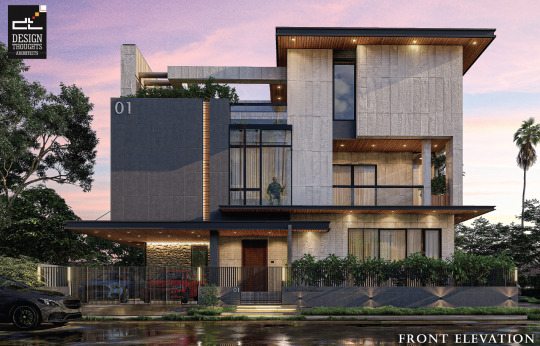
The residence's elevation, a striking blend of modernity and rigidity, represents our innovative design approach. Using clean lines, geometric shapes, and contemporary materials creates a unique and appealing facade for Mr Jerald’s residence.
Courtyards, a timeless architectural feature, have been a staple in modern home design for years. When Mr Jerald Joesph approached us with a unique request for a contemporary courtyard design, we were inspired to create a space that would genuinely enliven his family's home. This project, which has become a standout at Design Thoughts, is a testament to our commitment to innovative design. We are excited to share the project details, design approach, various planning stages, interior visualisations, and more in this blog. Primarily, we can't wait to unveil the unique courtyard design that sets this project apart, and we're sure it will pique your interest.
The elevation of Mr Jerald's residence is a testament to modern design. At the same time, the interiors are a harmonious blend of courtyards, water features, landscape, interior-exterior connection, and minimal yet luxurious finishes. This fusion of modern design with natural elements creates a contemporary space that invites you to explore and experience the home's unique charm and resonates with biophilic design principles.
Project fact file:
Plot size: 60 x 60
Built-up area: 4000 sq. ft.
Site orientation: South-west
Site advantage: Corner plot
Site topography: Flat site
Location: Spa Eco City, Sarajapur
Neighbourhood: Gated community gearing up for construction
Project architects: Ar. Madhuri, Ar. Avinesh Kumar, Ar. Harshavardhan, Ar.Mahantesh
Client persona
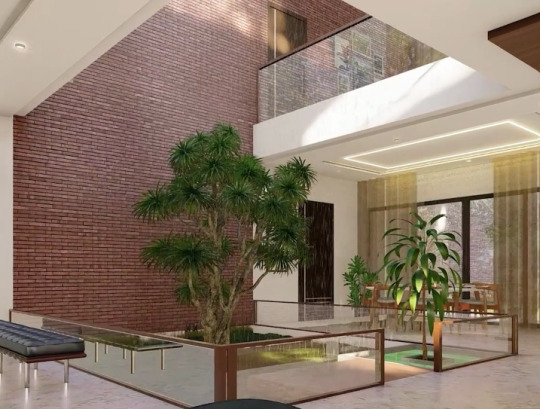
A nature-interactive courtyard in the centre of Mr Jerald’s house
Our client, Jerald Joesph, is an IT professional, and his wife is a dancer who loves yoga. With two kids, they envisioned a luxurious 4BHK with a G+1 modern home design. Their desire for a functional home over Vastu guidelines led us to the unique courtyard planning, which became the home's central attraction. They also favoured an open-plan concept allowing for double-height views from every part of the house. This vision of a functional, open, and luxurious home guided our design process and helped us create a space that truly reflects the client's lifestyle and preferences.
With courtyard planning, the clients were keen to alter the home's microclimate, which also brought in a nice connection between nature and the inside of the house. Moreover, they wanted a dedicated space on the terrace to provide solar panels to make the home sustainable. The clients completed detailed research of plans, reference pictures, and design ideas for their dream homes, which helped our designers understand their style.
Design evolution
Before any plan goes up to the execution level, plenty of planning strategies, discussions, revisions, and evolutions are involved. Through these blog posts, we are trying to make you understand these stages and get an idea about constructing a modern home design.
Courtyard planning and biophilia
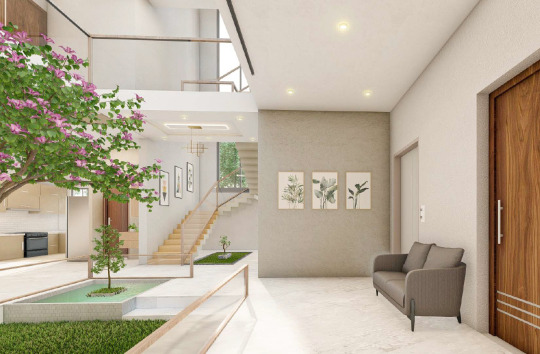
Connecting nature and human experiences
Biophilic design is an architectural concept that intends to bring elements from nature into design. On a broad aspect, scientific principles are carried in the design too. However, we can consider including aspects of nature like air, light, rain and natural textures for home designs. So when one enters such spaces, there is no disconnect in the user’s mind from nature. They will feel like part of nature, although confined between four walls.
Mr Jeralad’s home is a perfect example of a connection between the elements of the home and nature that accentuates the house's ambience, creating a space that makes you feel connected and at peace.
Courtyard planning and openness
The entire home plan on a 60x60 plot focuses on reducing the number of walls and following an open concept. Our designers zoned the private spaces like the bedrooms and servant quarters on the northeast side while almost the rest of the house on the ground floor seemed open. The staircase is on the south side. Strategically place the stair window to be visible from the road, making the elevation more interesting.
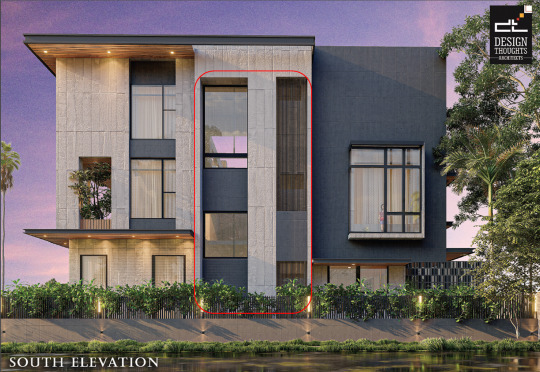
Staircase window as seen from the southern side road
On the other floors, private spaces are prioritised, yet the connection to the central courtyard is maintained. The rest of the spaces are dedicated to the dance area, all zoned on the terrace floor that opens to the terrace.
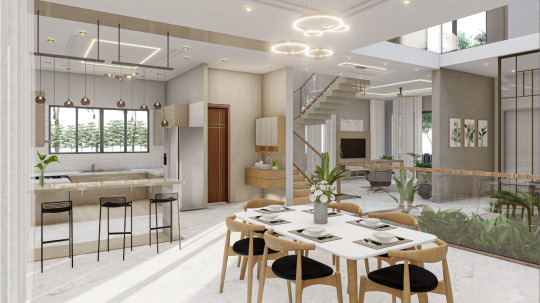
Envisioning the openness in the planning and interiors
Interior explorations
The interior altogether fosters a connection with nature. The central courtyard brings the dampness of the drizzles, the warmth of summers, the chills of the monsoons, and the lustre of springs into the house. We went for textures and finishes that complement this space as it connect each space.
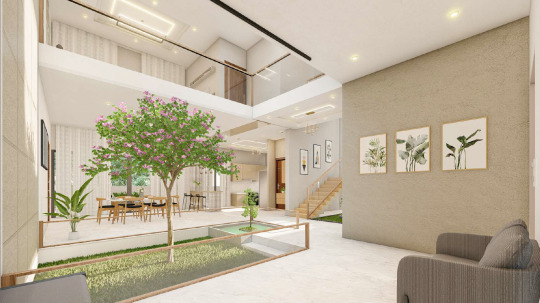
The enticing courtyard and water feature view from the foyer
Corner plot exterior
The exterior combines different textures and colours in a modern, contemporary tone. We bestow a mix of grey textures, including concrete, stone cladding, wooden false ceilings, and glazed windows with bold black framing.
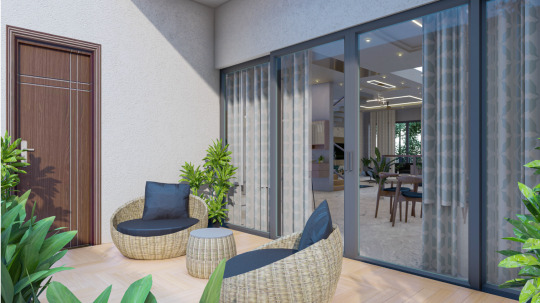

A view of the balcony from the in the interiors and as seen from the exterior
In this modern home design, we located the bay windows on both sides of the elevation in this corner plot to wrap it in glass and maximise the views for the bedrooms. For the balcony on the first floor, which opens up to the front, we added a nice corner view along with plantations that match the lushness of the inside.
As we can see, this pattern of greens along the balconies, railings, parapet, and grills beautifully adds a softness to the rigid concrete exterior.
The corner plot also facilitates the play of vertical and horizontal massing elements along various parts of the exteriors. We can also observe a uniformity of materials, such as wood-finished false ceilings for the horizontal aspects, while all the vertical elements are in grey stone and concrete cladding.
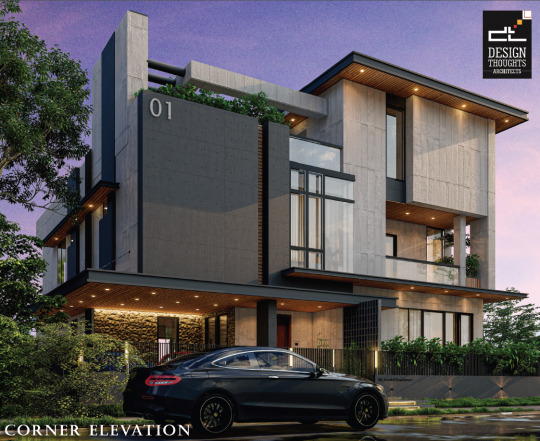
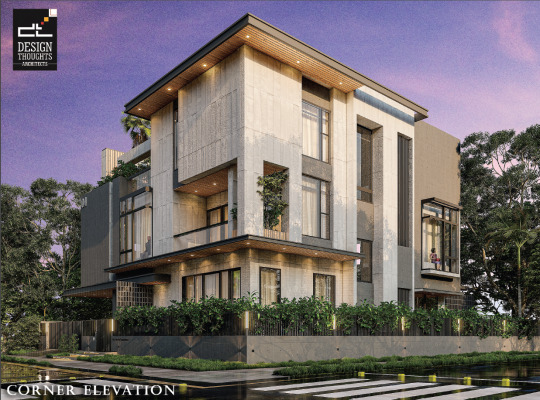
The elevation shows glazed box bay windows, tall stair windows, corner balconies, soft landscaping features, and rough textures.
Wrapping up
As we end the blog of one of our outstanding projects, we are happy about how the exterior and interiors hold on to that connection in design. The asymmetry in the exterior elevation exhibits the modernity in massing that holds the material variations together for the corner plot. This modern house design with a courtyard exemplifies how design transcends harmony, calmness and a sense of human psychology.
Check out a detailed spatial presentation of this home plan on a 60x60 plot here and our YouTube channel.
Drop your thoughts and comments on this blog post for interesting interaction and discussions with our designers.
For further design ideas and implementation, please contact us by mail or phone.
Join the Conversation: We value your ideas and are open to new design challenges. Reach us at [email protected], visit our website and follow us on Instagram at Design Thoughts Architects or Contact us on 7022169882.
Thank you for being a part of our design journey; we look forward to hearing your thoughts and ideas. Cheers to many more creative interactions ahead!
Writer,
Design Thoughts Architects
#Architects in bangalore#bangalore architects#Contemporary Architecture#modern architecture#interior design#home interior#courtyard design#Bengaluru Architects#house design ideas#Residential Architects#Modern House design#Dream Home#Home plans#Architecture plans#Biophilic design
0 notes